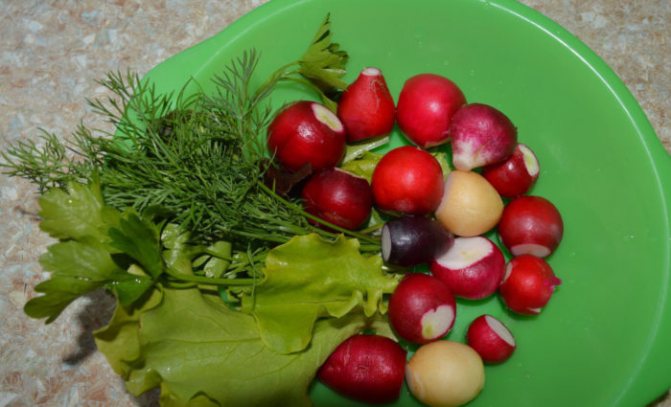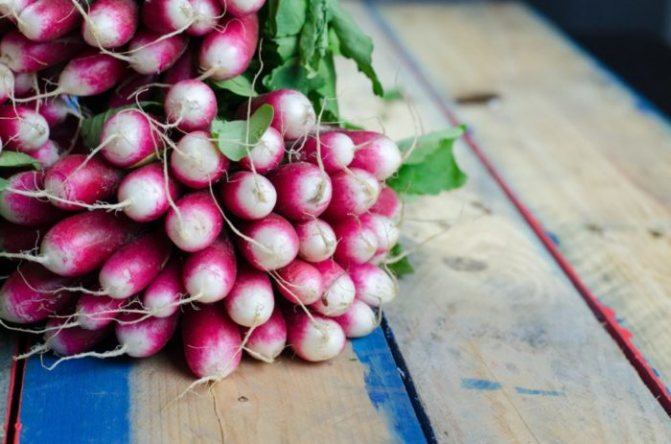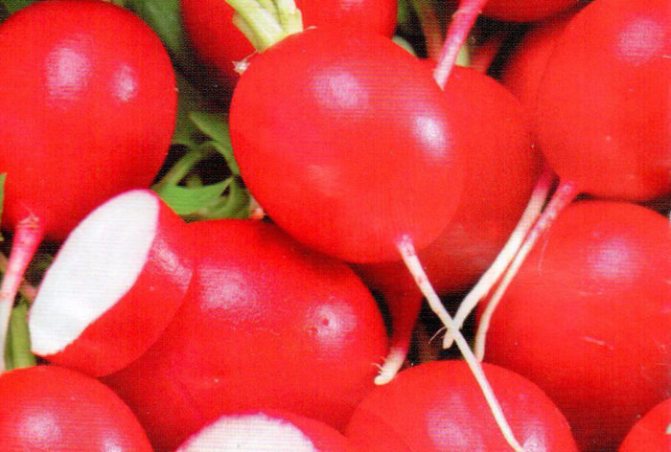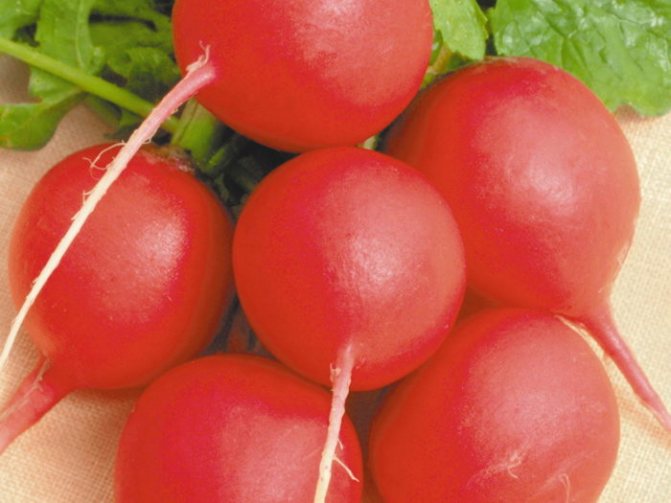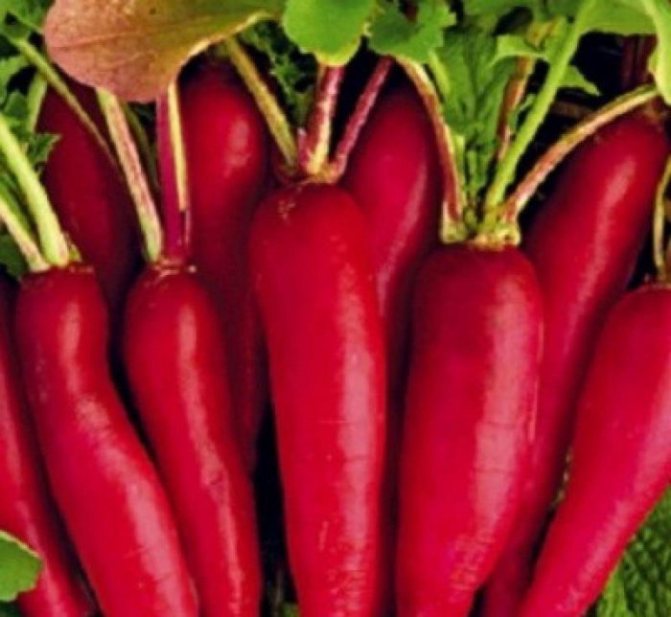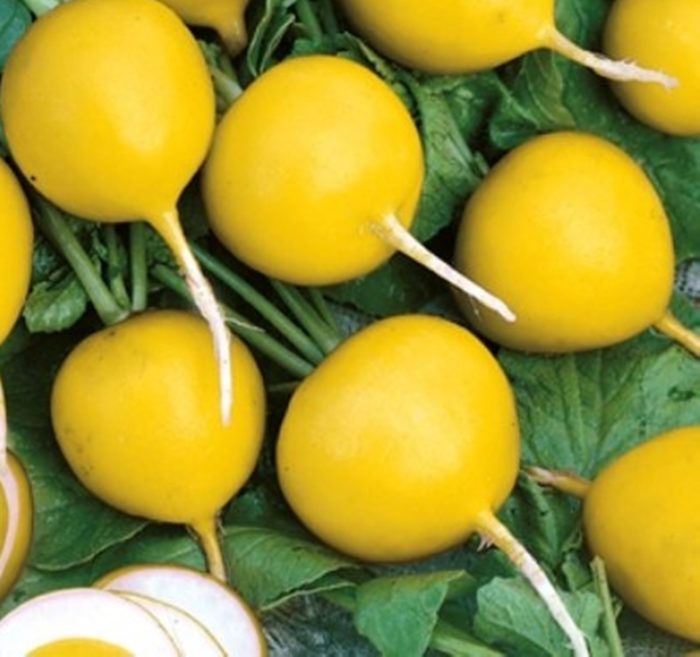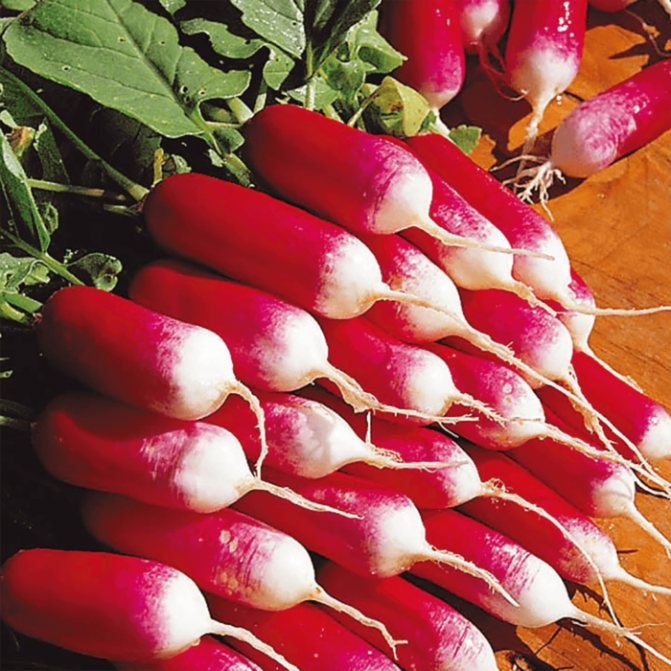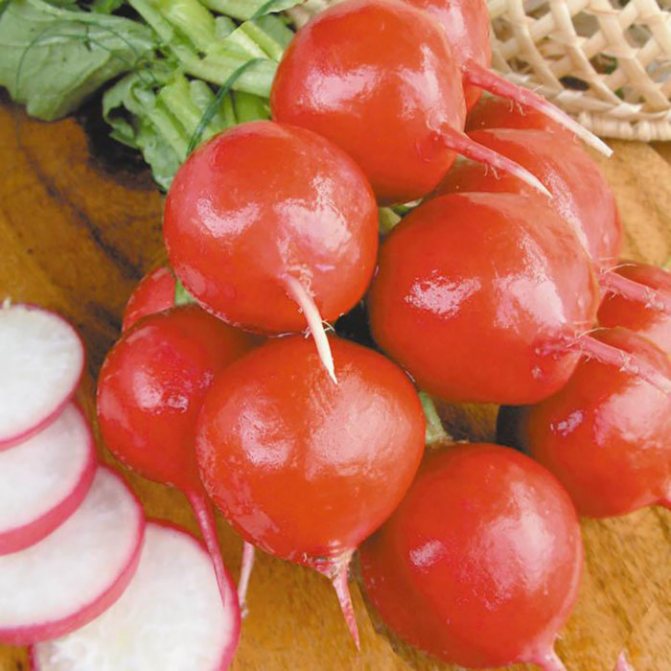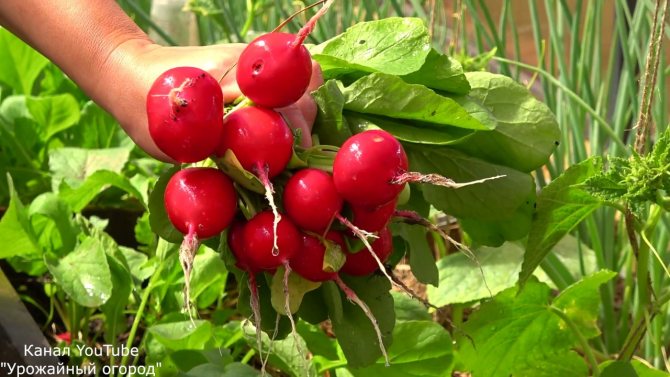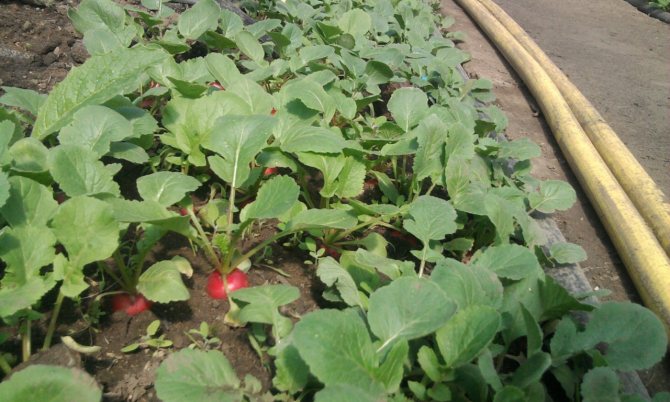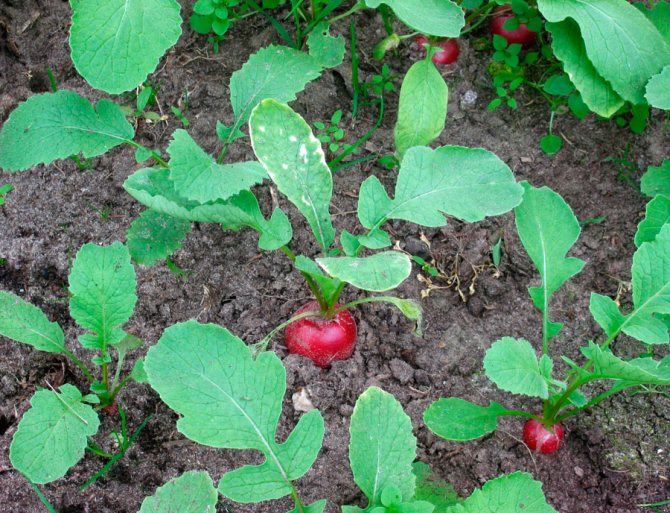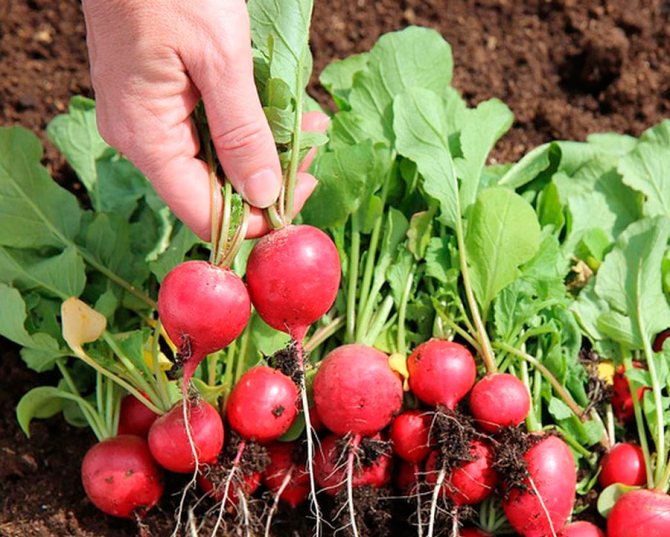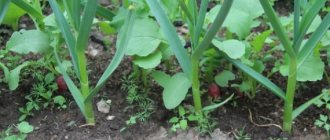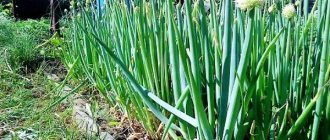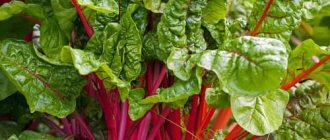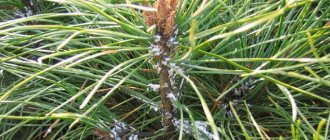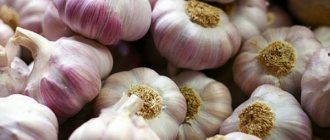What could be easier than growing radishes outdoors? I sowed seeds in the garden and after 3-4 weeks collect tasty and juicy roots! But not everything is so simple. Radish is not a capricious crop, but if you miss some of the nuances in planting and growing it, you can get a low quality crop or even be left without it. Therefore, before planting radishes, make sure you are doing everything right.
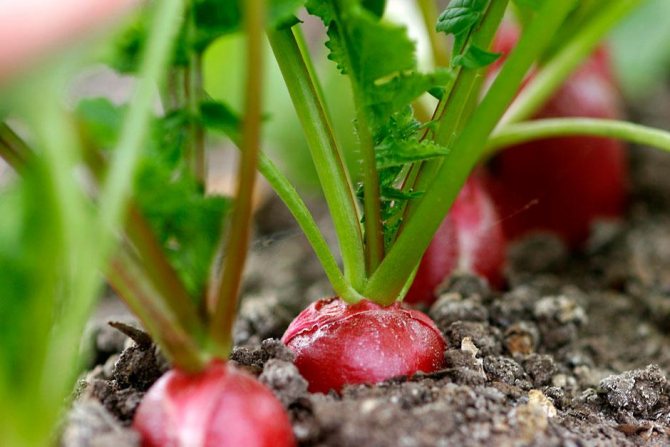
Growing radishes outdoors will require some knowledge of gardening.
The best varieties of radish for open ground
Radish Cherryet - medium late variety, ripening one month after germination. The leaf plates of the culture are compact, growing upward and to the sides. They are light green in color and obovate. The root crop has a rounded shape and a bright red hue. The radish pulp is juicy, white, tender and with a pleasant taste.
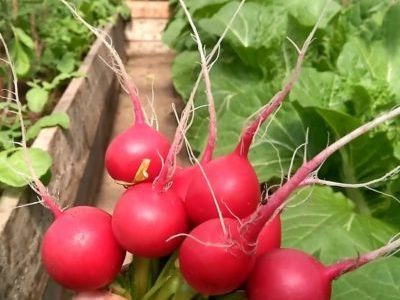

Radish Celeste - an early variety that ripens 20 days after germination. The culture has a compact leaf rosette with light green, not tall leaves. Root crops are rounded, with a tail. They have a bright red color and a characteristic radish smell. The taste of the root vegetables is sharp with a slight bitterness.
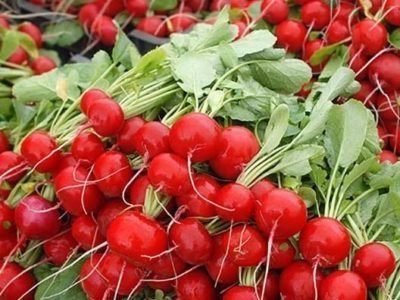

Radish Heat - medium early variety with high yield. The radish rosette is characterized by spreading and a small number of light green rounded leaf plates. Root crops are rounded, red-crimson, medium with a smooth, shiny surface. They have a dense, crispy white flesh with a spicy sweet taste.
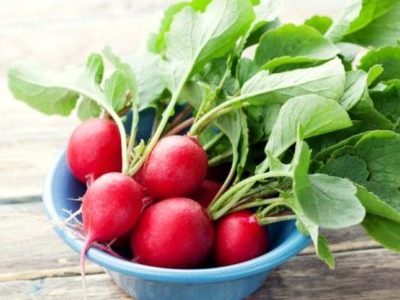

Sora radish - an early variety with a compact rosette and erect leaf blades, broadly ovate, gray-green in color with medium pubescence. Root crops are round, scarlet with white juicy pulp.
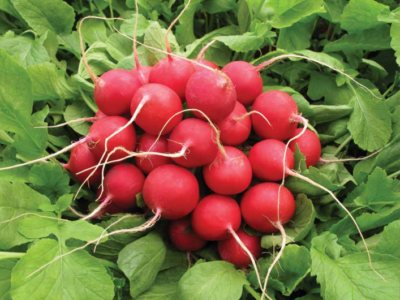

Radish Mercado - mid-season variety, ripening thirty days after sowing. The culture has a spreading rosette with obovate, green leaves. Radish roots are round, red in color with a thin tip. The pulp is white, sweetish-spicy, juicy and crunchy. The radish yield is high.
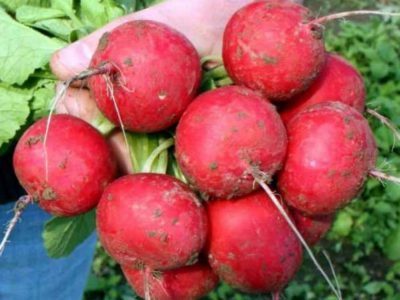

Radish Duro
The variety is mid-ripening and versatile. Root crops are large, round with a spherical shape, smooth surface and thin tail. The pulp is juicy, crispy, spicy-sweet white.
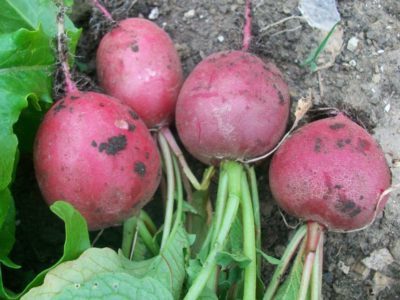

Sachs radish - an early variety with a round, red, small root crop. The flesh of the vegetable is juicy, crunchy with a pleasant taste. Radish has a high yield.
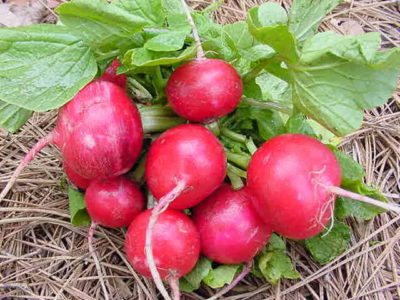

Radish Red Giant - late variety, ripening on the fiftieth day after planting. Root crops are large, elongated-cylindrical red-pink shade with juicy, white, spicy-sweet pulp.
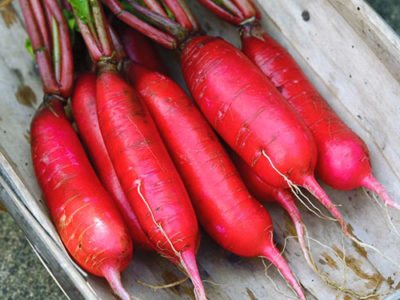

Radish 18 days - an early variety with a semi-erect leaf rosette. Leaves obovate yellow-green with medium pubescence. Fruits are large, elongated-cylindrical with a pink-red color and a white tip. The radish pulp is dense, tender, juicy with a slightly spicy sweet taste.
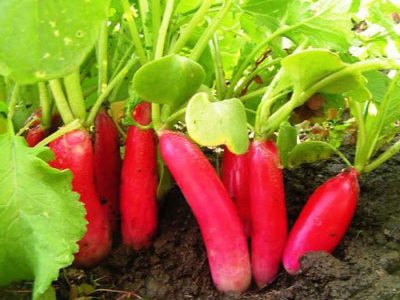

Radish Champion - early maturing variety with a half-raised rosette and green obovate, strongly dissected leaf plates. Root crops are red, oblong-rounded, ugly, of medium size. The pulp is crispy, juicy with a pleasant taste.
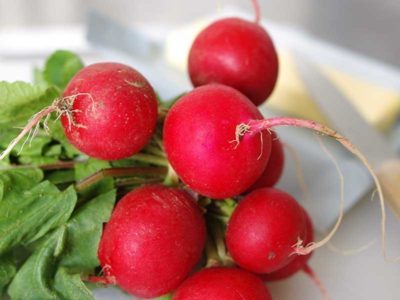

Radish Zarya
An early ripe variety with a semi-erect rosette and small medium-dissected green leaves with slight pubescence. Root crops are round-flat, dark red with an even surface. The pulp is juicy with a light spicy aftertaste.


Radish Alice's Dream - early ripening variety, ripening twenty days after germination. Root crops are smooth, round, red, medium in size. The pulp is tender, crispy, juicy with a mustard leaf taste.
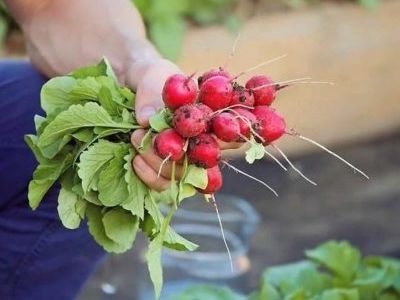

Radish Rudolph - an early ripe variety with a high yield and a low leaf rosette. Root crops are large, rounded, bright pink with white, juicy, crunchy sweet pulp with a slight bitterness.
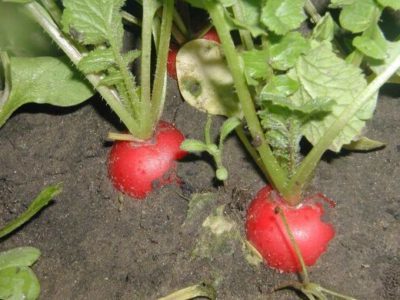

Radish Rebel - early variety with small, round, smooth, red roots. Radish flesh is white, juicy, crunchy with pleasant taste.
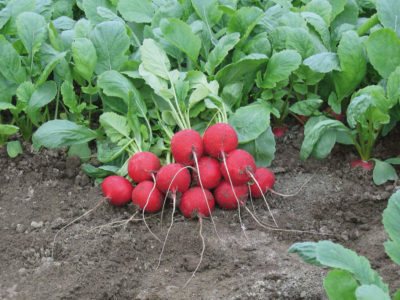

Radish Ascania - an early ripe variety with a high yield. Radish roots are large, red, elliptical in shape with a smooth skin. The pulp is tender, juicy, crunchy with a pleasant taste.
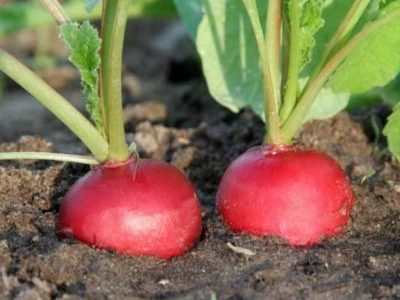

Radish Presto
Early variety. Root vegetables are medium, red with crispy and juicy pulp. In addition to the vegetable itself, you can also eat its leaves.
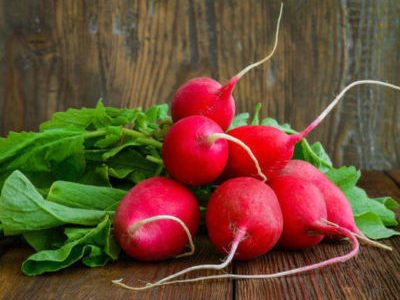

Radish Dabel - an early, high-yielding variety. It has compact leafy rosettes and large red roots with juicy, crispy pulp with medium sharpness.
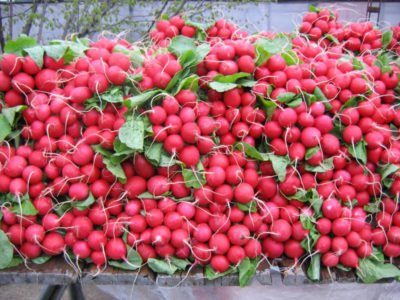

Radish Alyoshka - the variety is distinguished by its early ripeness and high yield. Radish roots are large, round, red in color. The pulp is juicy, white, crunchy with a characteristic radish flavor.
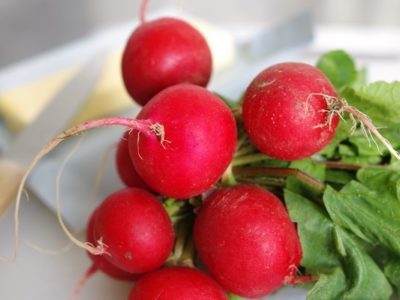

Radish Riesenbutter - an early ripening variety that ripens on the twentieth day after germination. Root crops are large with a shiny skin and white, juicy and sweet pulp.
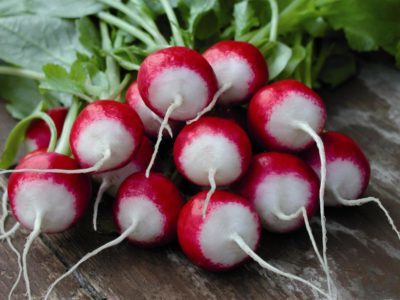

Radish Gloriet - an early ripe, high-yielding variety with a compact leaf rosette. Root vegetables are red, round, medium with juicy crunchy pulp, sweet taste with a slight bitterness.
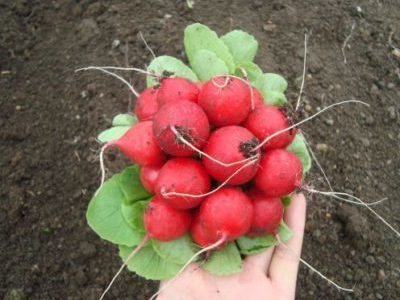

Presowing preparation and seed treatment
It is recommended that the seeds be purchased in stores, sorted and sorted by size. Leave a size of 3 cm. They give good germination and a large root crop. You can dip the seeds in a solution of salt (10 g per 200 ml), the floating ones are not used. Before planting, they are processed:
- stand for a day in water or on damp matter;
- immersed in hot liquid for 20 minutes - protection from disease;
- immersed in solutions of growth stimulants - enrichment with microelements;
- dry carefully.
Radish planting and care in the open field
Planting radishes in the garden is carried out earlier than other vegetables, since the seedlings are frost-resistant and easily tolerate night frosts. Seed sowing usually begins in late March - early April. For seeds to germinate faster, it is best to cover them with foil.
The time of planting seed in open ground in the summer will depend on the variety and maturity of root crops. Early varieties are planted in early June, varieties with an average ripeness in July, but not with seeds, but with seedlings. Late-ripening varieties are sown in August or even September.
Some gardeners sow radishes with the onset of the first frost before winter. This enables them to get a harvest much earlier than any early variety sown in spring ripens.
Seed preparation for sowing
It is best to purchase seeds from a specialty store. They are usually packaged in sachets ranging from 2.5 to 3 grams. One gram contains from 100 to 120 seeds. Their shelf life is four to five years. If the seeds of a culture have a normal shelf life, then they germinate in just a week. Germination can be improved by special preparation of seeds before planting.
First, the seeds should be sorted out and sorted by size. In order for them to sprout in the same time period, you need to choose seeds, the length of which will be from 3 centimeters.Before planting seeds in open ground, they should be soaked in cold water for a day. The day before sowing, they must be kept in hot water for 20 minutes in order to protect the seedlings from various ailments. Then the seeds need to be cooled, treated with a growth stimulant, dried and then planted in open ground.
Planting radishes in the open ground in spring
In order for the radish to grow and develop normally, it is necessary to prepare the soil in advance. It should be loose, drained and have an acidity of 5 to 5.5 pH. The garden bed should warm up well and be protected from the wind. The soil is prepared in the fall. The garden bed is dug up, any plant roots that come across are removed and compost is added. In the spring, before planting, the site is dug up again, adding mineral fertilizing to the ground.
Seeds should be planted 1 centimeter deep into grooves formed on the garden bed with a distance of 10 centimeters between them. Before planting seeds, the soil must be shed with hot water. Seeds are sown five centimeters apart. After planting, the grooves must be filled up, and the earth must be compacted so that they germinate faster. Then the garden bed must be watered and sprinkled with wood ash as fertilizer. In good weather, the seeds will begin to germinate on the fifth day.
Biennial radish varieties are usually planted in late autumn with the onset of frost. For winter sowing, late varieties with increased frost resistance should be used. Before planting the seeds, the garden must be dug up by mixing the garden soil with half a bucket of rotted compost, Art. a spoonful of double superphosphate and the same amount of potassium sulfide. This proportion is calculated for one square meter of the bed.
When planting seeds in winter, you do not need to spill the bed with hot water beforehand. After planting the seed in the ground, you need to mulch it with peat and cover it with a film, securing the polyethylene with boards or bricks. The harvest of radishes planted in this way appears in early spring.
Planting radishes in a polycarbonate greenhouse
If the greenhouse is heated, then it is possible to plant seeds in it in winter, but if not, planting should be carried out in the spring, since radish grows at a soil temperature of 10 to 12 degrees not lower. Planting should be carried out in March or April in pre-prepared soil.
The soil mixture in the greenhouse should be loose, fertile, have neutral acidity and be well drained. It is necessary to prepare and introduce the substrate into the greenhouse in the fall. To prepare the soil, it is necessary to mix garden soil with a small amount of peat, rotted compost, 30 grams of urea, 15 grams of potassium chloride and 40 grams of superphosphate.
This proportion is calculated for one square meter of the garden. Seed preparation and planting is carried out according to the same scheme as in the open field. After sowing, the bed must be sprayed with a spray bottle. In order for the seeds to germinate faster, the temperature in the greenhouse should be raised to 20 degrees. Also, seedlings need to be provided with regular watering, ventilation and fertilization, then the harvest will be good, and the roots are large.
Growing radishes at home on a windowsill
You can also grow radishes on the windowsill. It is best to grow it on a closed balcony, since in this case you can create the optimal temperature for the growth of the vegetable from 18 to 20 degrees and optimal lighting. If there is not enough light, the culture can be supplemented with phytolamps.
Containers for disembarkation must be taken with a depth of at least 15 centimeters. They should be filled with soil for growing cabbage mixed with peat. The preparation of seeds, planting them in the ground and caring for them is carried out in the same way as when growing in a greenhouse or in the open ground.
Growing radishes through seedlings
The seedling method is used when you want to grow radishes a few weeks earlier than usual. Early, high-yielding radish varieties are used for growing seedlings.You can plant it through seedlings twice a year: in early spring and late autumn. Seeds for seedlings are sown in March or September. They begin to germinate within five days.
For planting seedlings, plastic cassette containers with small cells are used, in which one plant is placed. The soil for the radish should be light, drained and fertile with neutral acidity. It is best to use a special soil for growing cabbage, mixed with peat. Seeds are prepared and sown according to the same method as in open ground, after planting, placing them in a well-lit room with temperature indicators from 18 to 20 degrees to accelerate the germination of seedlings, after covering it with a film.
Seedlings are not watered abundantly as the soil dries up and sprayed with warm water from a spray bottle. There is no need to fertilize the culture, since there will already be enough necessary substances in the ground. To harden the sprouts, after their appearance, the container with the seedlings is freed from the film and transferred to a cool room with a temperature of 8 degrees, and after 4 days it is brought back into a warm room.
Seedlings are transplanted into open ground in the grooves together with the soil. The spacing between seedlings should be at least 5 centimeters. After transplanting, the plants are watered with warm water and covered with foil for rooting for three days. Further care of the culture is carried out according to the standard regimen.
Planting radish according to the lunar calendar
Many gardeners take into account the current phase of the moon when planting vegetables. On the new moon, it is better to postpone planting work. Since during this period the juices of the plant accumulate and stagnate in the roots, and not in the upper part of the plant, as with the full moon, it is not recommended to transplant and plant vegetables in the new moon phase.
The growing moon is favorable for sowing vegetable crops that bear fruit above the ground, and the decreasing moon for plants with root crops. For this reason, radishes should be planted in the waning moon.
Onions are also a useful root vegetable. It is grown when planting and nursing in the open field without much hassle, if you follow the rules of agricultural technology. All the necessary recommendations can be found in this article.
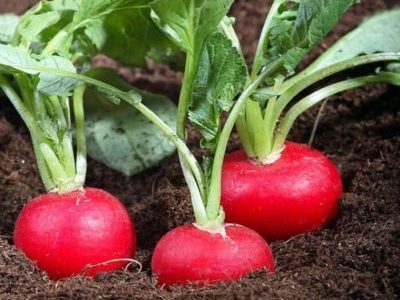

Reproduction of radish. How do I get radish seeds?
Radish belongs to cabbage plants. It has the property of cross-pollination, although it is also susceptible to self-pollination. You can get seeds in 2 ways - buying them in a store or growing seeds in your garden.
If the summer resident decided to grow a good harvest of radish, it is better to prepare the seeds yourself. This process includes several stages:
- Growing radish of different varieties from purchased material and choosing the best variety. To do this, write the name of the variety on the plate and stick it next to the corresponding planting. We write down the properties of each variety in a notebook. We use the largest and most delicious root vegetable for growing seeds.
- Removal of weak plants that have not given root crops.
- We do not use the selected variety for food, but leave it in the garden. After some time, the radish begins to “grow rustic”. This is the beginning of the seed ripening process. We cover the seed variety of the root crop with white matter so that there is no cross-pollination with other varieties that are not suitable for seed production. Before that, we pluck the flowers that have already appeared.
- We are waiting for the end of the flowering process and the formation of pods. In 14 days after the flowers fall, we remove the matter. Tie the sprouts with pods to the supports. We treat seed plants from pests.
- In August - September, we remove seed plants from the beds and dry them in the attic or somewhere else to a beige shade. To do this, we make bundles of plants using a rope or thread, grouping them by varieties.
- We remove the dried pods from the stem and grind them in our hands. It turns out a kind of tripe.It contains seeds and dust from the pods. We use a fan to separate the seeds. We blow on the resulting powder. In this case, unnecessary material flies away, and heavy seeds remain. You can also dip the ground material into water. Seeds suitable for sowing will settle to the bottom, excess material will float to the surface. We drain the water with unnecessary material, and dry the remaining seeds.
- We prepare paper bags, put dried seeds there, distributing them according to varieties. We write on each bag the type of radish and the date of receipt of the seeds. We store seeds in a ventilated area.
It is recommended to dip the grains into a mixture of clay and cow dung diluted with water until sour cream before planting plants on seeds.
Watering the radish
Radish is a moisture-loving crop, so watering should be frequent and abundant. In the first time after the emergence of seedlings during the formation of root crops, you need to water the garden once a day, thus, you can avoid bitterness in the ripened vegetable. But it is also impossible to overmoisten the culture, otherwise it will strongly crack and shoot.
If the spring is rainy, it will be necessary to water the crop early in the morning or after five in the evening. If the weather is dry, then you need to moisten the soil in the morning and in the evening.
Particular attention should be paid to the garden bed after germination. If the soil is constantly moist, it will eventually be possible to grow a juicy and tasty radish.
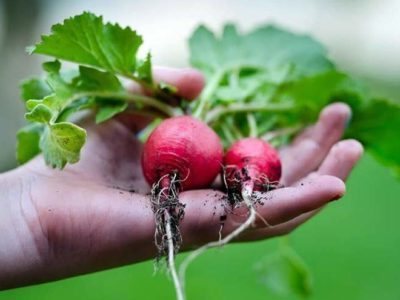

Planting a vegetable in egg cells
You can plant radishes in cardboard egg trays. This method is approved by many experienced summer residents, as it allows you to get root crops that have an ideal shape. Moreover, it eliminates the need for decimation. To plant radishes using this method, you must:
- Dig up and loosen the beds first. Level the soil.
- Cut off the bottom of the cells using a knife. Place the device on the ground with holes downwards, slightly pressing it down. Fill the cells with soil and place one seed in each of them.
- Sprinkle the crops with earth and water abundantly.
Soil for radish
A slightly acidic, nutritious, loose, sandy loam soil is ideal for a plant. The garden for planting radishes has been prepared since the fall. The site is dug up by introducing compost, potassium salt and superphosphate into the garden soil.
If the soil is clayey, in addition to the components listed above, peat and sand are added to it. Seed material is sown as soon as the snow melts.
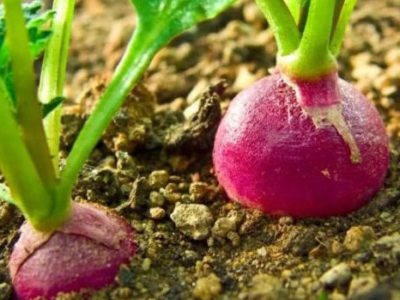

Fertilizer for radish
If the garden soil is depleted, then in order to feed the radish, it will need to be fertilized twice during the growing season. If it is planted in nutritious soil, then it will only need to be fed once.
You should be more careful with nitrogenous fertilizers, otherwise the growth will be directed to the tops, and not to the roots, and the latter will contain a lot of nitrates.
In order to have less nitrates in the radish, you need to fertilize it with a mixture of the following dressings:
- Compost;
- Saltpeter (15 grams);
- Superphosphate (10 grams);
- Humus;
- Potash fertilizer;
- Ash (1.5 liters).
The amount of compost or humus will depend on the size of the bed. For 1 square meter of the site, half a bucket of organic matter is taken. If the soil is fertile, then it is enough to apply only mineral fertilizers.
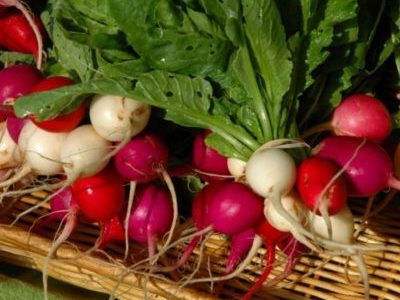

Preparing the soil in spring, we will ensure good early shoots
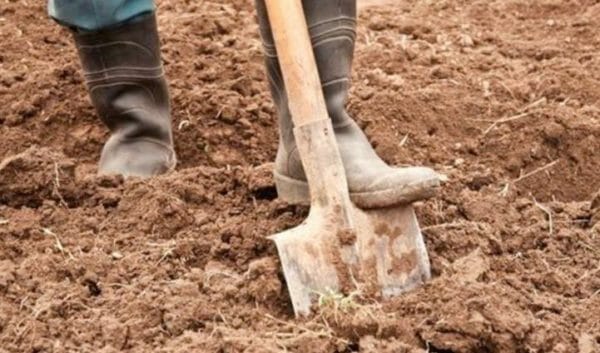

Preparing the soil for planting
In order for the radish to fully develop and grow, you need to prepare the soil for it. The culture feels good in loose, nutritious, well-drained soil, the optimum acidity of which is 5.5-7.0.
The place for this culture also plays a significant role. Preference should be given to a well-lit area that is protected from strong winds. As for the predecessors of radish, it is best to plant it in a place where potatoes, peppers, tomatoes, cucumbers and legumes grew.
Agronomists do not recommend growing radishes on the same bed for more than 3 years, since this root crop leads to weakening of the soil. It is best to select a new bed for a vegetable crop every year.
Preparatory work related to the soil should be carried out in the fall. It is necessary to remove plant residues from the site, dig it up, add compost or humus to the soil. After the winter leaves, when the earth warms up, it must be re-dug up and fed with mineral compounds.
Flowering radish
A radish bloom is only beneficial when seeds are needed. Otherwise, shooting and the appearance of inflorescences is highly undesirable.
Radish blooms 40 days after planting uterine roots. Inflorescences racemose, white. The flowering time lasts a month, after which the seeds used to propagate the radish begin to appear.
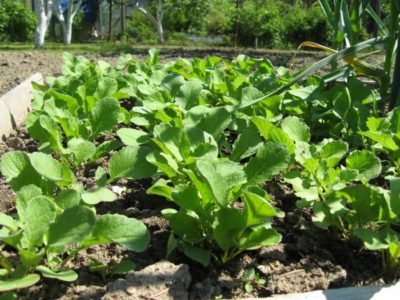

Freshly planted plant care, watering regime
Crop care involves the following manipulations:
- Maintaining humidity at a certain level. Watering is an essential condition for the full growth of radishes. After planting the seeds, you need to irrigate the beds every day, excluding the drying out of the top layer of the soil. Otherwise, the roots will acquire a bitter taste and grow small. The best time to water is morning and evening.
- Thinning of frequent seedlings. These actions must be carried out 5 days after the emergence of shoots. It is necessary to leave stronger sprouts. To ensure excellent ripening and high-quality fruiting of the vegetable, the seedlings should be placed at a distance of 5 cm.
- Loosening the soil. Excess moisture and its stagnation entail the formation of cracks in the roots and the appearance of black rot, keels. Diseases can be prevented. To do this, after watering, you should take time to loosen the soil. All actions must be carried out carefully so as not to damage the root and root crop in the process of growth.
- Top dressing with fertilizers. Radish reacts well to organic and mineral fertilizers. Each time after making the compositions, you need to cover the soil with a mixture of rotted manure and peat. Mulching will protect the plant from weeds, accelerate the penetration of fertilizers into the soil, and maintain an optimal moisture level.
- Protection against diseases and pests. It is important to regularly inspect plants for the presence of foci of disease and pests. If they are found, it is necessary to carry out treatment in a timely manner using appropriate means.
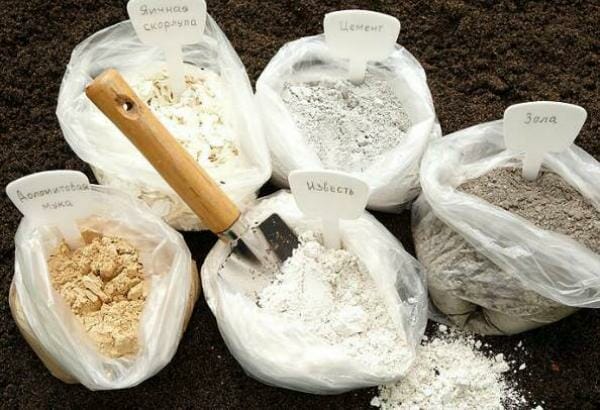

Soil cultivation and fertilizing products
201
Shelf life of radish
After the radish is collected, washed and freed from the tops, it is folded into boxes and removed to the basement. However, even with proper storage, root crops cannot be stored for more than a month, since they acquire flabbiness and bitterness.
If you store root vegetables in the refrigerator, then they can lie there for a maximum of one week. During this time, they should be eaten.
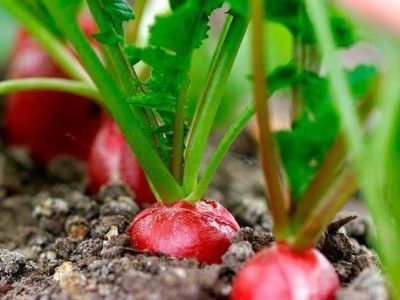

When to harvest radishes and how to store them
As the fruits ripen, selective harvesting should be carried out, which will make it possible for neighboring plants to develop better.
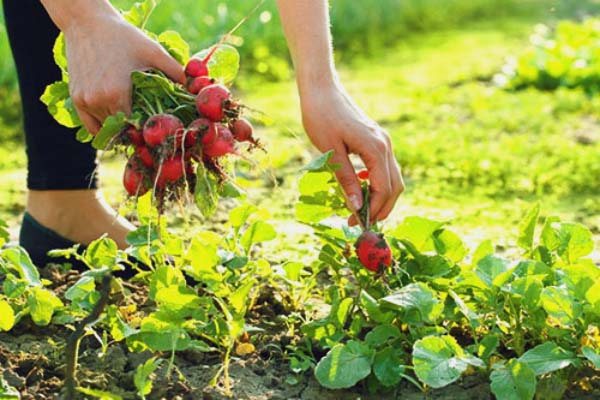

Harvesting radishes must be carried out, based on the size of root crops, in 2-3 stages, that is, first the largest, and after a week or another - the rest. Water the garden bed 2 hours before harvesting, which will make it possible to pull out the radishes without much difficulty. After that, it is recommended to peel the fruits from the tops and shorten the tip to prevent premature wilting.


For storage of radishes, it is recommended to use plastic bags, which are later placed in the vegetable compartment of the refrigerator. In this way, the fruits can be stored for several days.
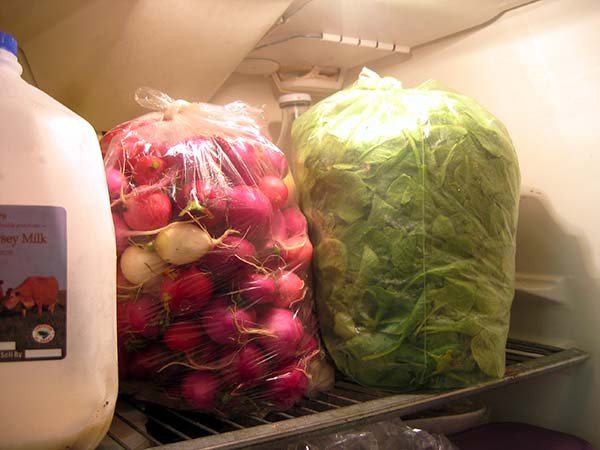

Thus, anyone, even an inexperienced gardener, can grow a good harvest of radishes, if they adhere to the above recommendations and simple rules for planting and care.
Video: how to grow radishes outdoors
Diseases and pests
Of the diseases, radishes can affect:
- Bacteriosis - with the development of this ailment, the tops begin to turn yellow, and the roots become slimy and rot. To eliminate the disease, the vegetable garden should be treated with Bordeaux liquid.
- Keela - growths begin to appear on the root crop, and the leaf rosette, along with the foliage, turns yellow and withers
- Powdery mildew - it will not be possible to get rid of this ailment. All affected plants must be removed and burned. After the procedure, the soil should be covered with slaked lime. It is not recommended to grow radishes on this site for four years.
From pests, radishes can infect white woman and cruciferous flea... So that these insects do not cause irreparable harm to the leaf plates and do not lead to the death of the vegetable, for prevention, the bed should be sprinkled with ash, and if the insects are still wound up, the site should be treated with the Actellik insecticide according to the instructions on the package.
Problems in growing radishes
Also, when growing radishes, the following problems can be observed:
- Shooting and pulling - Forcing shooters and stretching of plants can be observed when using low-quality seed material, late sowing of radishes, choosing an unsuccessful variety.
- Lack of root development - luxurious leaves and the absence of root crops can be observed in the event of a lack of illumination, an excess of fertilizers, deep embedding of seed in the ground, too abundant watering.
- Slow vegetable growth - this problem will be observed with a lack of nutrients in the soil, improper watering, insufficient lighting, non-compliance with the sowing time.
Subject to all agrotechnical rules and preventive measures when growing radishes, the harvest will be good, and pests and diseases will bypass the vegetable.
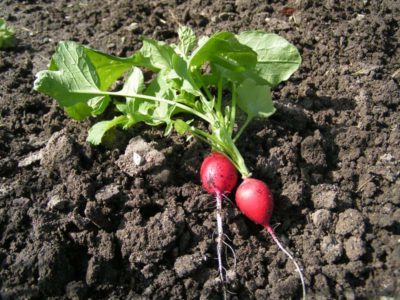

Problems with growing radishes
- If the roots became slimy and a rotten smell began to emanate from them, it means that the radish was struck by bacteriosis. Treatment with 1% Bordeaux mixture will help to eliminate this problem.
- With the formation of outgrowths and swelling, yellowing and wilting of foliage, you should start treatment for a fungal disease - keels. Lime milk, which is poured over the soil around the infected plants, will help. One plant will need a liter of such a product.
- Symptoms of the black leg are yellowness and curling of the leaves, darkening of the stem at the root. Affected plants are treated with a solution of copper sulfate and laundry soap.
The main pests of radish and the fight against them
A lot of trouble for radish beds is caused by pests, especially the cruciferous flea, which eats holes in the tops of the radish. If there is a lot of damage, the greens begin to wither, and the root crop itself does not gain the required mass and stops growing. The pest is especially dangerous for delicate radish shoots.
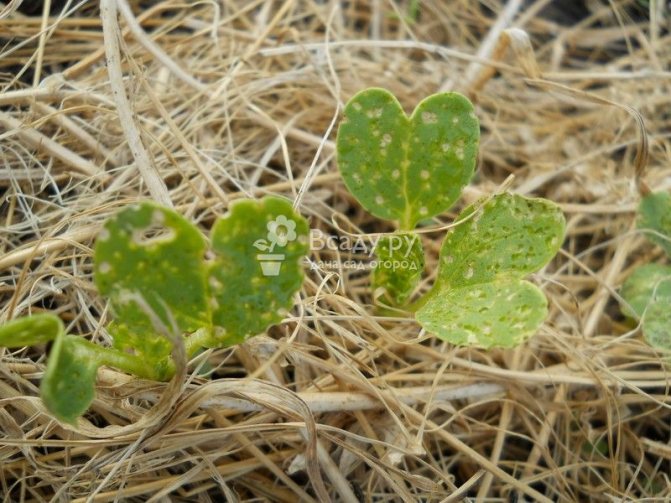

Radish Damaged by Cruciferous Flea
- To protect the plants, they are treated with ash. For ten liters of water, add two glasses of fresh ash and fifty grams of laundry soap.
- The second effective method is processing the leaves with tobacco dust (in the same proportions as with ash).
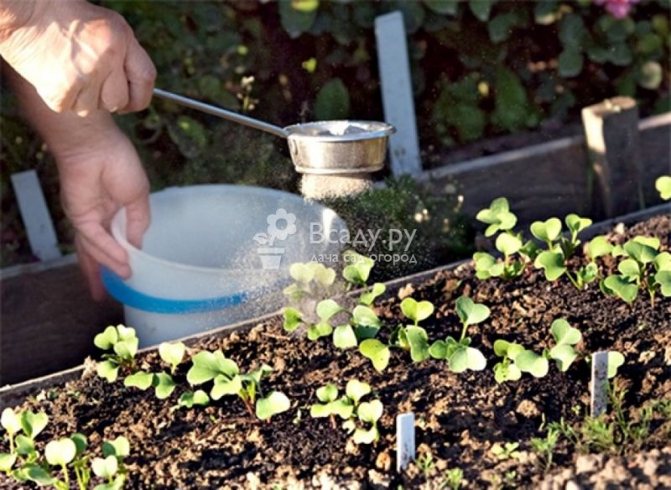

Treatment of radish beds with tobacco dust
- The most effective method of control is considered to be insecticide treatment, in particular Inta-Vir.
Belyanka is a dangerous pest of radish. The caterpillars of this butterfly eat the green tops of the crop. To protect the beds, they are treated with a solution of ground pepper, salt and mustard.
When growing radishes in summer, in hot weather, it is necessary to take protective measures against the bear. She does not often eat radishes, but can get into the garden and damage the crop.
Radish root crops often damage wireworms (large holes) and nematodes (rotted root base, small holes in radishes showing signs of decay).
- To protect against wireworms, the soil is fertilized with ammonium sulfate - two tablespoons of fertilizer per square meter. Such feeding will saturate the soil with nitrogen, and destroy the larvae of the pest.
- Fitoverm is effective against nematode. This powder is safe for humans. It infects the larvae of rootworm nematodes, which soon die of starvation.
- In the fight against the nematode, soil steaming is also used (watering with hot water from 60 degrees, a liter per square meter consumption), and its disinfection with chitosan-based preparations - Aldikabr, Vidata.
Radish benefits and harms to the body
Radishes contain many nutrients, including vitamins and minerals. The vegetable contains a lot of essential oils that give it a slight pungency and dietary fiber, which are necessary for the proper functioning of the intestines. One hundred grams of radish contains the daily requirement of vitamin C, and it also contains B vitamins.
Radish is rich in tocopherol, retinol, sodium, PP vitamins, calcium, zinc, potassium, fluorine, iodine, phosphorus, nickel, magnesium, cobalt and manganese. It contains a lot of saccharides and protein. The vegetable contains salicylic acid and anthocyanins, which are natural prevention of cancer.
Radish contains only 16 calories and helps to reduce the glycemic index in diabetics, therefore nutritionists advise to include it in their diet for people who are overweight and have problems with blood sugar.
Including radishes in your menu allows you to:
- Remove toxins from the body and improve the microflora in the intestines;
- Increase appetite and get rid of bile stagnation;
- Accelerate metabolic processes;
- Relieve muscle strain and joint pain;
- Help in the fight against rheumatism, sciatica and gout by using the vegetable in combination with medication;
- Eliminate sore throat and cough if there is radish with honey;
- Prevent caries, as it contains substances that destroy bacteria in the oral cavity;
- Replenish the lack of vitamins in expectant mothers, as well as get rid of constipation. However, pregnant women cannot eat large quantities of radish, as it causes gas formation;
- Remove excess fluid from the body and eliminate edema;
- Improve the flow of bile.
Also, grated radish allows you to eliminate bruises and bruises if you apply it to a sore spot as a compress.
The benefits of radish for women
Daily use of radish is an excellent prevention of breast cancer. In addition, its systematic use has a positive effect on the skin and gastrointestinal tract.
The inclusion of radishes in the diet allows you to normalize the water-salt balance, remove excess fluid from the tissues and rejuvenate the body.
During gestation, radish allows you to eliminate toxicosis and saturate the female body with the necessary substances that contribute to the proper development of the fetus.
Also, radishes help in the fight against extra pounds after menopause, when the body begins to produce fewer hormones responsible for maintaining a normal weight.
The benefits of radish for men
Men need to supplement their diet with salads with this vegetable. It will help enrich the body with trace elements and strengthen the heart and blood vessels.
Radish accompanies the cleansing of blood vessels from cholesterol plaques and cleans the intestinal walls from toxins, simultaneously improving the digestive processes.
In addition, the use of radishes helps men prevent the development of obesity, gout and diabetes. It also improves the functioning of the central nervous system and helps to cope with chronic fatigue.
How is radish useful for losing weight?
Radish belongs to the category of low-calorie foods. It accelerates metabolic processes and burns fat. The dietary fiber contained in the vegetable helps to normalize bowel function and eliminate constipation.
Radish tops are also very beneficial for the body. It gives food a spicy flavor and allows you to burn calories faster. It is best to combine a vegetable with those foods that contain polyunsaturated fats.
Radish harm to the body
Radishes should be avoided if gastritis, pancreatitis and ulcers are present. It is also contraindicated for people with allergies to its components.
In other cases, this spring-summer vegetable will be beneficial and will prevent many diseases.
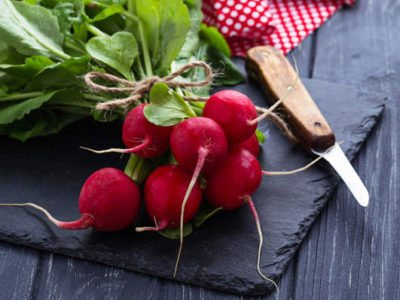

Radish use in cooking
Radish is mainly used in cooking for preparing spring salads with various ingredients. It is also served as a side dish for potatoes or meat, after marinating it. But nevertheless, it will be the most delicious, crispy and healthy fresh. We bring to your attention the most popular recipes, one of the components of which is radish.
Radish salad with cucumber and egg
The combination of egg, radish and cucumber gives the salad not only piquancy, but also makes it a wonderful spring dish with few calories. Therefore, if you want to enjoy a salad that will not affect your figure, be sure to try this recipe.
Ingredients:
- Pepper and salt to taste;
- Eggs - 3 pieces;
- Low-fat sour cream - 100 grams;
- Fresh cucumbers - 3 pieces;
- Radish - 120 grams;
- Salad - 1 bunch;
- Green onions - 1 bunch.
Preparing a salad with radishes and eggs:
We take eggs, boil, cool, clean and chop finely. Mix them with chopped radishes, lettuce, onions and cucumbers.
Season, season with sour cream, put in a salad bowl and serve. Bon Appetit.


Pickled radish for the winter
It is quite possible to eat radishes in winter, if you marinate them in advance in summer. It is quite simple to make such a linkage and it will take a minimum of time.
Ingredients:
- Radish - 1 kilogram;
- Bay leaf - 2 leaves;
- Garlic - 5 cloves;
- Black pepper in peas - 10 pieces;
- Dill sprigs - 3 pieces;
- Vinegar 9% - 0.5 cups;
- Salt and sugar - 2 tbsp each spoons;
- Water - 1 liter.
Cooking pickled radish:
We take garlic, clean and rinse. We sort out the radishes, wash them, cut off the tails and leaves. Wash the greens and dry them.
We wash and sterilize the cans. Put a little dill, radishes and garlic in each jar. You can lay out the ingredients in layers.
We make a marinade - boil water, put bay leaves, salt, pepper and sugar in it. Bring to a boil.
Pour in the vinegar and fill the radish with the resulting brine. We roll it up and put it in a warm place for a day.
After the time has elapsed, the cans can be moved to the basement. Bon Appetit.
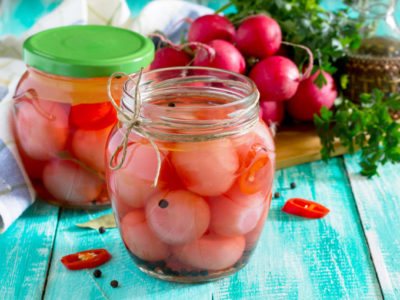

Fried radish
Fried radish may look unusual at first glance, but it tastes divine, especially when cooked as a side dish with fried meat.
Ingredients:
- Salt and pepper to taste;
- Radish - 500 grams;
- Water - 0.5 cups;
- Butter - 3 tbsp. spoons;
- Grain mustard - 1 tsp;
- Dill - 1 bunch.
Cooking fried radish:
We take the radishes, wash them, dry them and the regime in quarters. Preheat a skillet with oil and put the radishes on it.
Fry, stirring occasionally for 10 minutes. Add mustard, water, pepper and salt. Put out, covered with a lid for 10 minutes.
Put the radishes on a platter and serve with the meat. Bon Appetit.
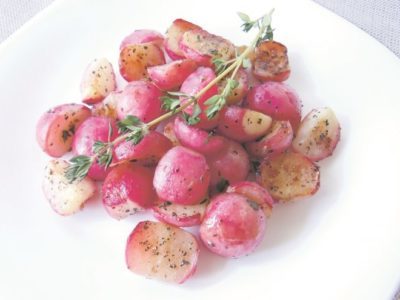

Radish tops salad
Radish tops are no less useful than the vegetable itself, besides, it helps to lose extra pounds and enhances metabolism. And if you combine it with herbs and oil, you get a delicious dietary salad.
Ingredients:
- Salt to taste;
- Radish with tops - 20 pieces;
- Green onions - 50 grams;
- Bulbs - 2 pieces;
- Sunflower oil - 4 tbsp. spoons.
Cooking lard from radish tops:
We take the tops, wash them and chop them into small pieces. Mode radish in circles and mix with tops. Onion mode with strips, chop the green onion finely.
We mix all the ingredients, salt and season with oil. Bon Appetit.


Arugula and radish salad
Italians are very fond of this unusual, light dish. It is prepared quite simply, and the result is simply excellent.
Ingredients:
- Salt and pepper to taste;
- Radish - 300 grams;
- Sunflower oil - 40 milliliters;
- Fresh cucumbers - 200 grams;
- Arugula - 200 grams;
- Sesame seeds - 2 tablespoons;
- Fresh tomatoes - 2 pieces.
Cooking arugula salad:
We take radishes, cucumbers and tomatoes. Wash, dry and cut them into thin circles. Wash arugula, dry it and tear it in large pieces.
Mix vegetables and salad, season with sunflower oil, salt, mix again and sprinkle with sesame seeds. Bon Appetit.
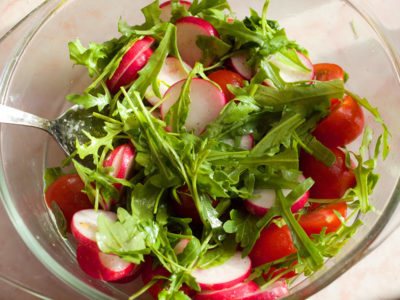

Radish salad with sour cream
The most common radish salad, but at the same time it is one of the most delicious and simple spring dishes that you can indulge yourself and your loved ones with.
Ingredients:
- Salt to taste;
- Radish - 500 grams;
- Parsley and dill - half a bunch each;
- Sour cream - 100 grams;
- Green onions - 1 bunch.
Cooking salad with sour cream:
We take the radish, wash it, cut it into circles, mix it with chopped herbs and onions.
Salt, add sour cream, mix and serve. Bon Appetit.


Landing dates on the lunar calendar in 2019 by region
Any gardener can grow radishes. Determining the time of its sowing, take into account that:
- sprouts will appear in 1-2 weeks at a temperature of + 0 ... + 10 ° С;
- within a week, if + 10 ... + 15 ° С;
- seedlings will be noticeable in 3-4 days + 15 ... + 20 ° С - the best option;
- lowering to -4 ° С is not scary;
- more than + 15 ... + 20 ° С is not desirable, because leaves will grow, not roots.
If there is a desire to extend the harvest, then sown every 2 weeks from the start of planting.
The earliest harvest is obtained by growing radishes in greenhouses. It is planted in open soil, after waiting for the snow to melt and lightly warming up. These terms depend on the climate of a particular region. Summer planting is carried out only using a dark covering material that protects the plants from the sun and prevents the arrow from forming. There is no point in planting without it.
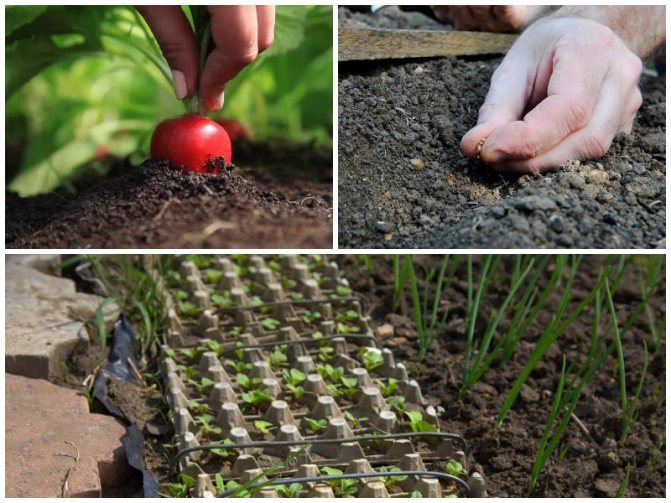

Varieties are chosen weakly arrowed and growing with long daylight hours. The specific landing dates are determined based on the lunar calendar.
| Region | Spring sowing | Summer sowing | ||
| Auspicious days | Unfavorable | Auspicious days | Unfavorable | |
| South of Russia (Krasnodar Territory) | March: 15-17, 23-25, 27-30 | March: 6, 7, 21 | | August: 15, 16, 30, 31 |
| Central European part of Russia (Moscow region) | April: 24-27, 29, 30 | April: 5, 19 | | July: 17 |
| Ural region, Western and Eastern Siberia, North-West | April: 24-27, 29, 30 | April: 19 | June: 9-11, 18-20 | June: 3, 4, 17 |
| May: 1-4 | May: 5 | July: 25-31 | July: 2, 3, 16-18. | |
Restricted days for planting: new moon and full disk.
Why do radishes dream
Usually, a vegetable dreams of success at work and making loyal friends. However, there are other interpretations as well.
- A large, ripe radish dreams of the appearance of a meticulous person in the dreamer's life.
- A wormy radish indicates that the planned celebration will not take place.
- A red and juicy root vegetable dreams of adventure.
- Radish in bunches portends a quick flirtation.
- Planting radish seeds in the ground is a symbol of an imminent vacation.
- If in a dream you dream of harvesting radishes, then in reality the dreamer will be disappointed and wasted time.
- Eating a salad with radishes in a dream means a forced deception.
As you can see, radishes are a pretty positive vegetable, even in a dream. Therefore, if you dream about it, hope for positive changes in your life that will bring many positive emotions.
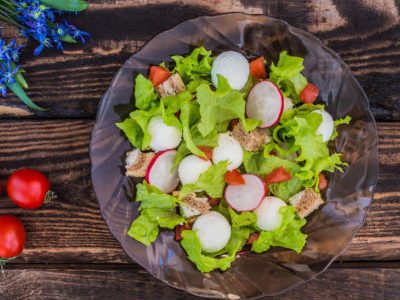

Preparation for sowing radishes
Planting radishes is not at all difficult. At the initial stage, the summer resident may be faced with the fact that the root crops will turn out to be loose and bitter. To eliminate this, you need to choose the right variety and adhere to the cultivation techniques. You can be content with a generous harvest, provided that all the intricacies of planting radishes and preparing the soil are observed.
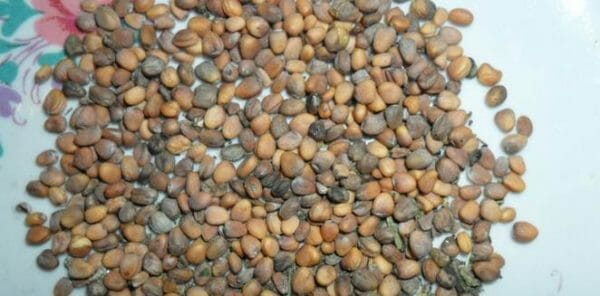

Radish seeds for planting

